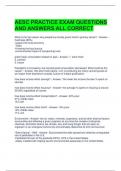AESC PRACTICE EXAM QUESTIONS
AND ANSWERS ALL CORRECT
What is the top reason why people buy locally grown food in grocery stores? - Answer- -
freshness (83%)
-support the local economy
-Taste
-Knowing the food source
-environmental impact of transporting food
green bean consumption based on type - Answer- 1. store fresh
2. canned
3. frozen
Population is increasing, but canned good consumption decreased. What could be the
cause? - Answer- We want fresh beans -U.S. is producing too many canned goods so
we import fresh beansfrom outside Culture of instant gratification
how does income effect savings? - Answer- The lower the income the less % spent on
savings
how does income effect housing? - Answer- the average % spent on housing is around
29-26% regardless of income
how does income effect transportation? - Answer- 20% poor
21% middle class
15.5 rich
how does income effect food? - Answer- 16% poor
12% middle class
11% rich
Environment - Answer- the air, water, minerals, organisms, and all other external factors
surrounding and affecting a given organism at any time the complex of physical,
chemical, and biotic factors (as climate, soil, and living things) that act upon an
organism or an ecological community and ultimately determine its form and survival
"Silent Spring" -1962 - Answer- Documented the wide spread and relatively unregulated
use of pesticides in the U.S.
-Facilitated the ban of the pesticide DDTin 1972 in the United States.
-widely credited with helping launch environmental awareness in the United States
,Environmental awarness - Answer- -is the recognition that humans are active
participants in ecosystemsand possess the power to help or hurt the environment
around them.
-advocates the sustainablemanagement of resources and stewardship of the
environment through changes in public policyand individual behavior
NEPA - Answer- -January 1, 1970: President Nixon signs NEPA (National
Environmental Protection Act
-The EPA consolidated federal research, monitoring and enforcement activities into a
single agency.
-EPA's mission is to protect human health by safeguarding the air we breathe, water we
drink and land on which we live
The U.S. Clean Air Act - Answer- December 31, 1970: U.S. Congress authorizes the
EPA to set national air quality, auto emission, and anti-pollution standards. The first
major environmental law in the United States to include a provision for citizen suits
The U.S. Clean Water Act - Answer- -October 18, 1972: The Clean Water Act (CWA)
establishes the basic structure for regulating discharges of pollutants into the waters of
the United States and regulating quality standards for surface waters.
-The basis of the CWA was enacted in 1948and was called the Federal Water Pollution
Control Act, but the Act was significantly reorganized and expanded in 1972.
Eutrophication(or more precisely Cultural Eutrophication or hypertrophication) - Answer-
is the depletion of oxygen in a body of water, which leads aquatic animal death. It is a
response to the addition of excess nutrients, mainly nitrogenand phosphorus, which
induces unnatural, accelerated growth of plants and algae, the decaying of which
consumes oxygen from the water
Where is commercial fertilizer applied? - Answer- the mid-west
Agriculture impacts the environment -of course!BUT is Agriculture getting blamed for
more than its share of that impact? - Answer- Many Agriculture professionals say YES!
It is common for religions to: - Answer- -abstain, or be forbidden, from consuming
certain foods and drinks
-restrict foods and drinks during their holy periods of time
-associate dietary and food preparation practices with rituals of the faith.
Buddhism - Answer- All living beings are sacred: has translated to widely practiced
vegetarianism and veganism
•Violence towards animals = human aggression, thus
•Ahimsa(non-violence or harmlessness): avoid all foods related to processes where
harm was done
•Fasting is common
, Christianity - Answer- Communion (aka "Eucharist") involves eating bread and drinking
wine (or substitutes) to represent the body and blood of Jesus Christ
Church of Jesus Christ of Latter Day Saints (Mormons)-No coffee, tea, alcohol, meat
sparingly
•Seventh Day Adventist-Modified vegetarian diet, no alcohol
•Catholicism-No meat on Ash Wednesday and Good Friday
Hinduism - Answer- •Vary based on sect
-Avoidance of killing any anima
l-No meat, fish, alcohol, eggs, or milk
-Fasting at festivals
-Feasting at festivals
-No beef (cow sacred)
Islam (Halal) - Answer- •No pork
•No blood
•No alcohol
•Fast/Feast during Ramadan
•All food must be prayed over
•Only animals slaughtered invoking the name of Allah can be eaten
Judaism - Answer- •The Torahpermits only animal species which both "chew the cud"
and have cloven hooves (i.e., Koshermeat)
•No blood
•No seafood without fins and scales
•Meat and Milk must be prepared/servedseparately
•No grapes/wine produced by non-Jews
•Ritual fast and feast
Religion gives food a higher importance than just nutrition.Religious beliefs make
partaking of food a - Answer- Moral issue: concerned with the principles of right and
wrong behavior and the goodness or badness of human character
Principles of Religion - Answer- •Belief in something sacred (for example, gods or other
supernatural beings).
•A distinction between sacred and profane objects.
•Ritual acts focused on sacred objects.
•A moral code believed to have a sacred or supernatural basis.
•Characteristically religious feelings (awe, sense of mystery, sense of guilt, adoration),
which tend to be aroused in the presence of sacred objects and during the practice of
ritual.
•Prayer and other forms of communication with the supernatural.
•A world view, or a general picture of the world as a whole and the place of the
individual therein. This picture contains some specification of an over-all purpose or
point of the world and an indication of how the individual fits into it.





